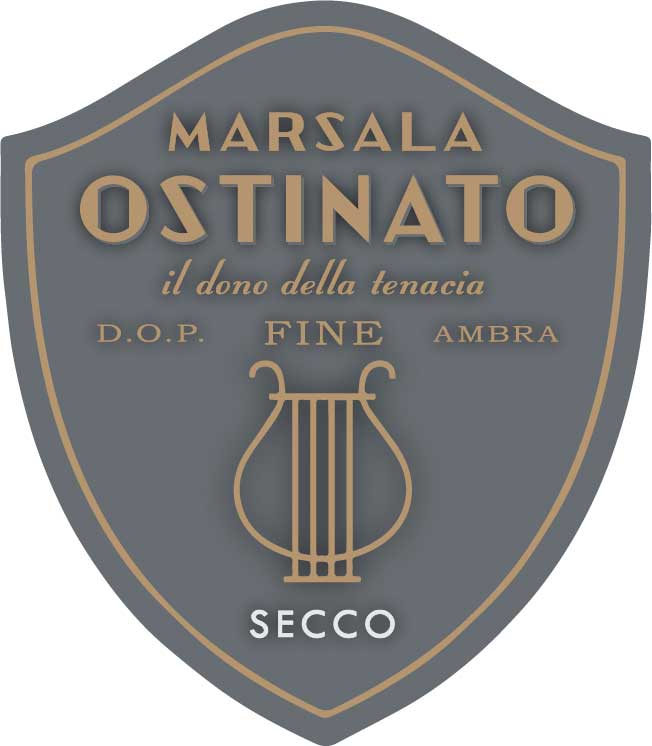Ostinato Marsala Fine Ambra Secco

|

|
Delicious, balanced and refined, Ostinato Fine Ambra Secco is a dry Marsala that is produced according to traditional methods now rarely seen in the appellation, especially in Fine expressions. It begins with its ‘alto grado’ base wine, from late-harvest, low-yielding Grillo, Inzolia and Catarratto old vines. Its higher natural ABV means the wine is less reliant on fortification and is more expressive of Marsala’s indelible terroir. Extended aging beyond the minimum Fine requirements produce a Marsala that resonates with deep vinous character.
Enjoy with dry-cured meats and a wide variety of cheeses, including Robiola, Taleggio and all manner of Pecorino cheeses. It also excels in a variety of cocktail applications—a 1:1 with Hayman’s London Dry Gin and Fine Ambra Secco is highly recommended—as well in elevating classics like Veal or Chicken Marsala, Saltimbocca or sautéed mushrooms. Once opened, this wine will keep for up to six months.
(50-59ºF)
(55-64ºF)
(59-64ºF)
About Alagna

With nearly 50 hectares under vine and plots in the Marsala, Marzara and Salemi communes, Baglio Baita Alagna is one of the few Marsala producers that continue to own and work their own vineyards. Founded in the early 1940s by Giuseppe Alagna, these vineyards enable third-generation winemaker Ercole Alagna to produce ‘alto grado’ Marsala from late-harvest, low-yielding old vines, farmed along organic lines, without irrigation. The winery is in the classic baglio style and is built over medieval grottos extending down nearly 35 meters, several stories below street level. There, traditional Marsala varieties Grillo, Inzolia and Catarratto rest in a wide variety of ancient Slavonian and American oak barrels. Ostinato Marsala is Sotolon Selections’ multi-year collaboration with the Alagna family, founded on the traditional methods and the ‘alto grado’ that have largely been abandoned in the appellation. The results are a Marsala Fine Ambra Secco and Fine Ambra Dolce of high-vinous character and unusual complexity, equally at home in the glass as they are in the pan. Full details
About Marsala DOC
Marsala is one of the world’s best known yet most misunderstood wines. Today, it is largely thought of in cooking contexts, but its origins are as one of the world’s foremost fortified wines, akin to Port, Madeira, Sherry and the Vin Doux Naturels of France (Rivesaltes, Maury and Banyuls). In terms of its production, it is arguably more complex—or complicated—than any of its fortified peers.
‘Marsala wine’ has been produced on the northwest corner of Sicily for centuries, and its antecedent—vino perpetuo—stretches back at least to the Greeks and the Romans, more than two millennia ago. The modern history of Marsala begins in 1773 with the arrival of Englishman John Woodhouse and subsequent fortification of its ‘perpetual wine’ for trade to England. Fellow Englishman Benjamin Ingham’s study of its vineyards and especially the formation of its ‘base wine’—including an adaptation of the solera system of Xérès—was codified in his 1836 Decalogo and ushered in Marsala’s golden era. Marsala first gained DOC appellation recognition in 1969; its rules were revised in 1984, outlawing the most egregious examples of ‘flavored marsalas’ that had led to its debased reputation.
Today, Marsala is produced in a complex variety of styles, with classifications made according to color, age-expression and sweetness levels. It is typically made from the white grapes Grillo, Inzolia and Catarratto, now planted predominantly to productive guyot and tendone systems. With their labor demands and lower yields, traditional albarello (bush) vines are now rare but still highly prized for the best Marsalas.
For producers seeking to rediscover what once made Marsala the equal to other great fortified wines, work begins in the sand and limestone ‘tufa’ vineyards, with lower yields and later harvests producing an ‘alto grado’ base wine that enables a greater vinous expression, less reliant on the interpolations of mosto cotto, sifone (mistella) and fortification. At its best, Marsala offers a unique expression and compelling flavor profile, redolent of tamarind, grilled apricot and orange; white chocolate, vanilla and roasted almond; cinnamon, tobacco and mace, lashed with sea salt and the concentration wrought by the warm, dry Scirocco wind. These rare examples are the Sicilian countryside and the Mediterranean Sea in a bottle, and a trip back in time.
| SKU | Vintage | Region | Origin | Desc | Cepage | % Alc | Size/Pack | Finish | BTL Barcode | Cs Barcode | Cs Wgt |
|---|---|---|---|---|---|---|---|---|---|---|---|
| HZ 6400 | NV | Sicilia | IT | Oxidative/Oxidized Wine; Fortified | Grillo, Inzolia, Catarratto | 17.0% | 500/12 | T Cap | 8015792000802 | 18015792000809 | 12.70 kg |



